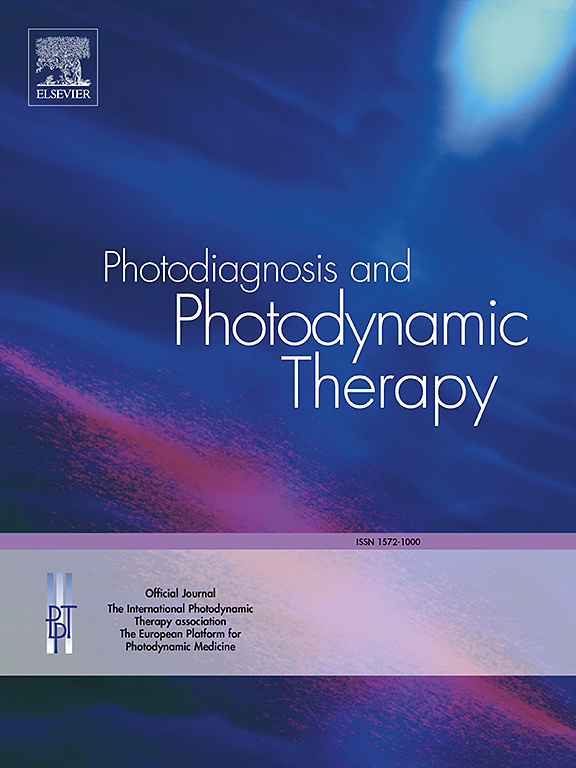Comparison of efficacy of ALA-PDT and CO2 laser in the treatment of vaginal intraepithelial neoplasia II (VaIN II)
IF 3.1
3区 医学
Q2 ONCOLOGY
引用次数: 0
Abstract
Objective
To compare and analyze the efficacy as well as adverse effects of 5-aminolevulinic acid photodynamic therapy (5-ALA-PDT) and carbon dioxide (CO₂) laser therapy in the treatment of vaginal intraepithelial neoplasia II (VaIN II), and assess the feasibility, safety, and influencing factors of ALA-PDT.
Methods
A retrospective review was conducted on the clinical data of 79 patients with VaIN II (PDT group = 37, Laser group = 42) who were treated at the Gynecology Department of the Affiliated Hospital of Qingdao University from January 2022 to January 2024. Follow-up evaluations were carried out at 3, 6, and 12 months after treatment. During these follow-ups, human papillomavirus (HPV) testing, cervical liquid-based cytology (TCT), colposcopy, and vaginal lesion biopsy were utilized to assess key outcomes, including the lesion reversal rate, HPV clearance, and treatment-related adverse reactions in both groups.
Results
The lesion reversal rates following ALA-PDT treatment were 83.3 %, 86.1 %, and 88.2 % at 3, 6, and 12 months, respectively. There was no significant difference when compared to the laser group. However, the negative HPV conversion rates at 6 and 12 months after ALA-PDT treatment were 73.5 % and 87.5 %, respectively, which were significantly higher than those observed in the CO2 laser group (P < 0.05). Adverse events related to photodynamic therapy occurred in 13.5 % (5/37) of the cases, which was significantly lower than the 35.7 % (15/42) in the laser group. In the laser group, increased incidences of vaginal bleeding and scarring were observed. Logistic univariate regression analysis revealed that factors such as a disease duration of >1 year, multifocal lesions, and a history of cervical cancer or precancerous surgery negatively influenced lesion reversal at 6 months after ALA-PDT treatment (P < 0.05). Additionally, factors like patient age over 50 years old (menopause), having more than two pregnancies, an imbalance in the vaginal microbiota, a prolonged HPV infection (lasting >1 year), and HPV superinfection affected HPV clearance at 6 months after ALA-PDT treatment (P < 0.05).
Conclusion
For the treatment of VaIN II, ALA-PDT exhibits equivalent lesion reversal rates and superior HPV clearance compared to CO2 laser treatment, while causing minimal anatomical disruption to the vaginal tissue.
ALA-PDT与CO2激光治疗阴道上皮内瘤变II型(VaIN II)的疗效比较。
目的:比较分析5-氨基乙酰丙酸光动力疗法(5-ALA-PDT)与二氧化碳(CO₂)激光疗法治疗阴道上皮内瘤变II (VaIN II)的疗效及不良反应,评价ALA-PDT治疗的可行性、安全性及影响因素。方法:回顾性分析青岛大学附属医院妇科2022年1月至2024年1月收治的79例VaIN II患者(PDT组 = 37,激光组 = 42)的临床资料。在治疗后3、6和12个月进行随访评估。在这些随访中,利用人乳头瘤病毒(HPV)检测、宫颈液基细胞学(TCT)、阴道镜检查和阴道病变活检来评估关键结果,包括两组的病变逆转率、HPV清除率和治疗相关不良反应。结果:ALA-PDT治疗后3、6、12个月病变逆转率分别为83.3%、86.1%、88.2%。与激光组比较无显著差异。而ALA-PDT治疗后6个月和12个月HPV阴性转阴率分别为73.5%和87.5%,显著高于CO2激光治疗组(P < 0.05)。与光动力治疗相关的不良事件发生率为13.5%(5/37),明显低于激光治疗组的35.7%(15/42)。在激光组中,观察到阴道出血和瘢痕的发生率增加。Logistic单因素回归分析显示,病程超过1年、多灶性病变、宫颈癌或癌前手术史等因素对ALA-PDT治疗后6个月病变逆转呈负相关(P < 0.05)。此外,患者年龄超过50岁(绝经)、两次以上怀孕、阴道微生物群失衡、HPV感染时间延长(持续1年以上)、HPV重复感染等因素影响ALA-PDT治疗后6个月的HPV清除率(P < 0.05)。结论:与CO2激光治疗相比,ALA-PDT治疗VaIN II具有相同的病变逆转率和更好的HPV清除率,同时对阴道组织的解剖破坏最小。
本文章由计算机程序翻译,如有差异,请以英文原文为准。
求助全文
约1分钟内获得全文
求助全文
来源期刊

Photodiagnosis and Photodynamic Therapy
ONCOLOGY-
CiteScore
5.80
自引率
24.20%
发文量
509
审稿时长
50 days
期刊介绍:
Photodiagnosis and Photodynamic Therapy is an international journal for the dissemination of scientific knowledge and clinical developments of Photodiagnosis and Photodynamic Therapy in all medical specialties. The journal publishes original articles, review articles, case presentations, "how-to-do-it" articles, Letters to the Editor, short communications and relevant images with short descriptions. All submitted material is subject to a strict peer-review process.
 求助内容:
求助内容: 应助结果提醒方式:
应助结果提醒方式:


